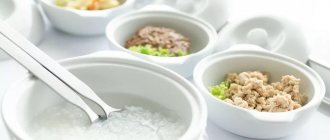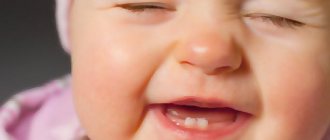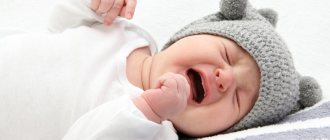After birth, babies need time to adapt to their environment. One of the manifestations of this adaptation is diarrhea during breastfeeding in a newborn, which can make every mother worry. And this is no coincidence, because during diarrhea, the baby’s body quickly becomes dehydrated, which is fraught with serious consequences. That is why a mother should know what exactly is called diarrhea and how to provide first aid to her baby.
What happens to a newborn's intestines in the first days of life?
Every adult's intestines are normally populated with the required number of microorganisms (bacteria), which are not harmful, but on the contrary, beneficial. They actively reproduce and form the intestinal microflora, which is the basis for a healthy body.
But in a newborn, there are no bacteria in the intestines; they begin to appear only in the first days of his life, or rather in the first hours. In the uterine cavity, the baby’s body was in a sterile state, and, coming out of the mother’s womb, with the first portion of inhaled air and contact with it, he receives the first doses of bacteria. They immediately settle on his skin and enter the body with inhaled air.
Mother's milk contains colostrum, which immediately penetrates the baby's gastrointestinal tract, populates it with beneficial bacteria and helps the germ of microflora to successfully form.
In the first days of a child's life, loose stools are entirely explained by breastfeeding. The mother produces milk only on the third day, but in the meantime the baby sucks colostrum, which has a natural laxative effect. This is necessary so that the child’s body is cleansed as quickly as possible of the waste that has accumulated in it during intrauterine growth. The first black feces are what they are.
After being freed from waste, a period of active formation of digestion begins in the child’s life. It is often accompanied by colic and pathological gas formation. After the microflora is fully formed, all problems go away and the baby stops suffering from tummy disorders. That is why irregular loose stools in the first weeks of life are rather the norm, because the body is just learning to digest food and may malfunction. But there are also cases when you really need the help of a specialist - more on that later.
Prevention
You can prevent the appearance of green stools using preventive measures. After all, it is much easier to prevent a pathological deviation than to cure it when it appears.
Prevention is as follows:
- visit your pediatrician regularly;
- avoid overeating, monitor your diet (it is recommended to eat at the same time);
- if necessary, give your baby dietary supplements to improve the functioning of the digestive system;
- if you feed your child new foods that he has not eaten before, be sure to monitor his body’s reaction to see if the baby has allergies;
- introduction of complementary foods should be timely;
- When choosing infant formula, you should follow your doctor's recommendations. Do not skimp on them under any circumstances;
- During breastfeeding, the mother must also follow a special diet.
Ignoring changes in stool color in an infant can lead to serious consequences. Such deviations, as a rule, negatively affect the functioning of the digestive system. A child may suffer from dehydration caused by prolonged diarrhea combined with green stools. If the cause of “greening” is some disease, then the lack of timely medical care can lead to complete damage to the body by necrotic or putrefactive processes.
Thus, green stool in an infant is absolutely no cause for concern if this is the only symptom and if there are no other signs of an intestinal infection.
What should normal stool look like in a newborn?
The pattern of changes in the color and consistency of feces in a newborn baby can be presented in the table (however, it is important to understand that some deviations from the norm may occur without serious cause for concern - this is due to different diets and characteristics of the baby’s body). The table is universal for breastfed children.
Table 1. What should normal stool look like in a newborn?
| Age | Feces are normal | Feces with diarrhea |
| 1 - 3 days of life | The stool is black-green in color and has a thick sticky consistency. | Liquid, foamy, black-green in color. |
| 3 – 7 day | Liquid dark yellow or greenish stool. | Watery, foamy, yellow-green in color. |
| 7 – 21 days | The masses begin to take shape, the color is dark yellow. | Unformed, liquid consistency with a greenish tint. Foreign inclusions are possible. |
As for the frequency of bowel movements, in the first days of life, when intrauterine waste is released, 3 to 4 “trips to the toilet” per day are considered the norm. When the color of the stool begins to change to light yellow, the number of “cleanses” is reduced to three times, which will be the norm over the next two to three weeks. Further, for the entire period of breastfeeding (before the introduction of complementary foods), the baby should defecate two to three times a day.
Also, in the first weeks of life, you may find dark inclusions in the baby’s stool. This is rather the norm, because the intestines are just learning to digest incoming food, and if the baby generally feels good and is active in behavior, then there is no need to sound the alarm. Another thing is if you find blood clots in your stool, this is a reason to immediately consult a doctor. Blood is a warning sign.
Main reasons
There can be many factors contributing to the appearance of a green color. As noted earlier, green feces in newborns less than 1 week old is the norm. This is how his body gets rid of meconium. A little later, the color of the stool changes to brownish or yellow, slightly reminiscent of mustard. Doctors also consider such changes to be the norm, but if you have the slightest doubt about the baby’s condition, you should immediately consult a doctor. In addition, after birth it is also necessary to follow a special diet and monitor the child’s nutrition.
When breastfeeding
As a rule, the color of stool in a breastfed baby is yellow or brown. The stool has a mushy consistency, sometimes liquid. Has a sour smell. But sometimes the color may change, as well as the consistency. For example, small particles of foam, mucus, or streaks of blood may appear in the stool.
The main reasons for green stool during breastfeeding include:
- decreased activity of lactase (an enzyme that promotes the breakdown of lactose in the body);
- accumulation of bilirubin in large quantities;
- dysbacteriosis;
- the consequences of taking certain medications by a nursing mother;
- consumption of certain foods (zucchini, cucumbers), which, if ingested through breast milk, can cause a change in the color of stool;
- oxidation of feces upon contact with air.
Most of these factors can be ruled out on your own by looking at your diet. But in some cases, unfortunately, it is impossible to do without serious drug treatment.
Artificial Chair
The stool of bottle-fed babies is significantly different from the stool of a child receiving mother's milk: it is thicker in consistency, yellower in color, and more similar in smell to the smell of adult feces. The consistency of the baby's stool should remain unchanged unless the parents change the feeding formula.
Green stool in a bottle-fed baby may appear due to the formula the baby is fed. Some manufacturers fortify them with iron to prevent newborn anemia. But sometimes it causes green poop in the baby. In order to exclude this reason, it is enough just to change the feeding formula and observe the child’s diapers. If the color of the contents has returned to normal, then there is no longer any cause for concern.
The introduction of complementary foods into the baby's diet can also cause green feces in the baby. You should pay special attention to its consistency. If it is not liquid and does not have a strong odor, then there is no cause for concern. Some babies begin to salivate profusely when their first teeth erupt, and excess saliva enters the baby's esophagus and intestines, irritating it. The intestines react to such irritation by the appearance of green poop, which in this case is an absolutely natural process.
But if the child’s stool turns green, and at the same time has an unpleasant odor, interspersed with mucus, then the mother should think about an urgent visit to the doctor who is monitoring the baby.
Signs of diarrhea in infants during breastfeeding
The main diet for babies up to one year is liquid food. Consequently, his stool will often be liquid-like. This moment often causes young, inexperienced parents to panic, and it begins to seem to them that the child has diarrhea. How can you tell if your baby really has diarrhea?
- The number of bowel movements increases several times;
- The stool becomes watery or greenish;
- The presence of a sour odor;
- The tummy is in a swollen state.
If a newborn has green diarrhea, this indicates a violation of the intestinal microflora, as a result of dehydration and prolonged loose stools. The growth of pathogenic bacteria increases, which leads to frequent colic or rash. Yellow diarrhea is most often caused by food and is typical for those babies who are bottle-fed. In addition, it can be provoked by pathogenic bacteria. Here you need to carefully monitor your child; if diarrhea continues for more than a day, you should immediately see a doctor.
Diarrhea with mucus can occur during infectious diseases, and at the same time it will be considered normal. If the nature of its appearance is completely different, then you should immediately seek help from a specialist. If a child has diarrhea with foam and at the same time there is general malaise and an increase in body temperature, then hospitalization is immediately required. This suggests that a viral infection is spreading inside at high speed, which can cause irreparable harm.
When should you really worry?
The most undesirable thing that can be indicated by green feces in a baby is an intestinal infection. But in this case, the color of the stool will definitely not be the only symptom. If there is an illness, the baby will feel really bad, and an attentive mother will easily see signs of infection. Signs of an intestinal infection
:
- Liquid, frequent (up to 18-20 times a day) stools of gray-green or dark green color (possibly with mucus, foam) with a putrid, pungent unpleasant odor.
- Vomit.
- Increased body temperature, chills.
- Pale skin, perspiration.
- Headache, rash.
- Refusal to eat, moodiness, frequent crying.
It is worth noting that the most dangerous thing in any intestinal infection is dehydration. Why? Because with diarrhea and vomiting, the baby loses enormous amounts of fluid and salts. If parents know what to do and know how to make up for these losses (it turns out to give the baby enough to drink, ideally with special solutions for oral rehydration), then in more than 90% of cases, complete recovery can be ensured independently at home. However, the situation is dangerous and you urgently need a doctor if:
- There is blood in the vomit or stool.
- You can't get your child drunk.
- There are signs of dehydration.
The easiest way to control whether the baby has enough fluid in the body is the frequency, color and smell of urination. If there is no fluid deficiency, then urination is once every 1-2 hours or more often, the urine is light in color and practically odorless. It’s convenient to track all this using a disposable diaper - how often it gets wet.
If the baby does not pee for 6 hours or more, this is a dangerous situation, which clearly indicates that there is a risk of dehydration, which means you were unable to give him something to drink at home, and you urgently need to see a doctor to replenish the fluid deficiency with IVs in the hospital.
Causes of diarrhea in a newborn
The main reasons for the development of diarrhea in a newborn can be:
- Changes in the diet of a nursing mother.
- Infections.
- Mom taking medications.
- Antibiotics.
- Poisoning.
- Surgical reasons.
- Teething (for older children).
- Allergies, dysbacteriosis.
Let's consider each reason separately.
E. Komarovsky's opinion - what should mom eat?
A well-known doctor reminds that diarrhea in infants fed breast milk is often caused by poor nutrition of the mother. This applies not only to products that have a laxative effect, but also to possible allergens. Komarovsky urges nursing mothers to experiment less with nutrition and limit as much as possible cocoa, citrus fruits, strawberries, coffee and other products that can act as allergens.
According to the doctor, everything that a mother eats certainly ends up in her milk. That is why you should not eat foods that can worsen the smell or taste of milk. As for diarrhea in babies, the mother's consumption of white cabbage or legumes can make the baby's stool looser and more frequent. When trying any product, the mother should monitor the baby, and if the baby does not have a rash and the stool has not changed, then you can increase the amount of the product in the diet.
Infections
Infections can be bacterial or viral. A child can become infected with them if hygiene rules are not observed sufficiently. The mother should wash her breasts well before feeding, monitor the hygiene of surrounding objects and the baby’s bed, and not allow the baby to be held by strangers in outer clothing in the first weeks. In addition, if the mother herself becomes infected with the infection, it can be passed on to the baby through her milk.
Sterilization of bottles (when feeding formula) is also an important hygienic operation to prevent unwanted infections.
Mom taking medications
Any medications enter the baby’s body through milk. This is especially true for antibiotics - they instantly provoke dysbiosis (an imbalance of beneficial bacteria in the intestines) and will certainly provoke diarrhea.
If antibiotics were prescribed to the child himself, then they are the cause of loose stools. Consult your pediatrician and tell them about the unpleasant consequences of taking medications. Perhaps he will make another appointment or prescribe drugs that correct the microflora.
Surgical reasons
Surgical reasons include:
- abnormal intrauterine development of the intestine;
- appendicitis (accompanied by severe abdominal pain in a child);
- pathology of the pancreas.
A careful examination of the newborn by the doctor and the use of all available diagnostic tools will help to recognize the cause of the disorder in time and eliminate it.
Teething
Children begin to erupt their first teeth at different ages. Full range: from three months to eleven. When teething, salivation reflexively increases, and it is this that provokes the development of diarrhea. A large amount of fluid enters the lower gastrointestinal tract and thins the stool. As a rule, after the tooth comes out, salivation stops and stool returns to normal.
One cause of teething diarrhea is bacterial infection. The baby begins to put everything in his mouth, and if the hygiene of the surrounding area is insufficient, a microbe may enter.
Allergies
Allergies can develop if a nursing mother contains certain foods in her diet:
- Citrus.
- Chocolate, sweets.
- "Overseas" fruits.
- Red vegetables, etc.
You should also pay attention to the formula that the baby is fed (with artificial feeding) - it can also cause allergic reactions.
Causes of green diarrhea
There are many root causes of green diarrhea Infants green stools when they consume only “foremilk” or when feces become oxidized when exposed to air. At the same time, the number of bowel movements does not differ from the norm. In children older than one year, this may be due to nutritional factors or serious illnesses. The causes of the disease may be the following pathologies :
- Dysbacteriosis;
- Allergic reaction;
- Cow's milk protein intolerance - lactose intolerance;
- Food poisoning;
- Infectious or bacterial diseases;
- Intestinal infections: dysentery, rotavirus, salmonellosis, amoebiasis, giardiasis;
- Diseases of the digestive tract;
- Pyelonephritis in young children;
- Nervous system diseases
- Diseases of the endocrine system: Addison's disease, congenital adrenal hyperplasia, thyrotoxicosis;
- Worm infestations;
- Celiac disease;
- Cystic fibrosis;
- Liver diseases;
- Disaccharidase deficiency;
- Eating large amounts of greens, green fruits, green food dyes;
- Taking certain medications.
We can conclude that only a doctor can make a correct diagnosis, and therefore carry out treatment. In case of illness, first aid must be provided, but not self-medication .
Symptoms of diarrhea
The following clinical symptoms exist, depending on the type of diarrhea:
- Enteral diarrhea is caused by inflammation of the mucous membrane of the small intestine. It is characterized by copious discharge up to 4-6 times a day, which may contain pieces of undigested food. Accompanied by pain in the abdomen and around the navel.
- Colitic - appears when there is inflammation of the lower intestines. Manifested by frequent bowel movements up to 10-15 times a day, painful urges. The discharge is small and may contain blood and mucus.
- Gastric diarrhea occurs when the secretion of gastric enzymes is reduced, causing indigestion and rapid emptying of the stomach. The stool increases in frequency up to 4-6 times a day, has a liquid consistency, is dark in color and may contain remnants of undigested food. Sometimes it has a putrid smell. The patient is bothered by a feeling of fullness and dull arching pain in the pancreas.
- Pancreatic - occurs when the secretion of the pancreas decreases. Manifested by a moderate increase in heavy discharge. The stool has a pasty or liquid consistency and contains mucus. Characterized by an unpleasant putrid odor, pain in the upper abdomen, and flatulence.
- Diarrhea in children can present with many symptoms . The main symptom of the disease is repeated green diarrhea, which occurs more than 3 times per day in children over one year old, and more than 10 times in children under one year old. Other manifestations include: nausea, vomiting, belching, flatulence, abdominal pain, blood, mucus and food particles in the stool.
Treatment of diarrhea in newborns
Treatment of diarrhea in newborns can be divided into two stages:
- First aid at home;
- Drug intervention.
Help at home should be provided by the mother and as soon as possible. Initially, you need to try to find the cause of diarrhea; if it is diagnosed, eliminate it as soon as possible.
First aid for a newborn
You can’t risk your baby’s health by trying to treat diarrhea on your own. The danger is that if the intestines are upset, the baby’s body becomes dehydrated very quickly. Lack of water in a child's body can become a serious threat to his health and even the life of your baby. The mother should give the baby liquids as often as possible.
The baby will drink willingly because he is very thirsty due to dehydration. But he will be reluctant to eat or even refuse food until he feels better. If the cause of the illness is mother's milk, the baby should not be breastfed until the woman's stool is restored. Does your baby have a high fever? Before the pediatrician arrives, his condition can be alleviated with a small amount of syrup, which includes paracetamol.
Treatment of diarrhea in infants
If a baby has diarrhea, treatment should begin from the first hours. Parents' actions should not be aimed at directly suppressing diarrhea, but at replenishing lost fluid and salts. The following are the first measures of assistance.
- Breastfed babies should be put to the breast as often as possible.
- To replenish fluid loss, it is better to use specially prepared solutions sold in pharmacies (for example, “Naturalite” or “Pedialite” electrolyte solutions, but consult your doctor first).
- Infusions of blackberry leaves, dried blueberries or pomegranate peels have a positive effect on the condition of the intestines.
If within 2 days parents cannot independently cope with the child’s discomfort, he should be shown to a pediatrician and receive the necessary advice.
Medical attention may be needed if:
- the child developed pallor, chapped lips, and dry mouth;
- high fever and vomiting appeared;
There was a suspicion that the baby's diarrhea was caused by taking medications.
Why then can the stool be green?
A common cause is certain foods that are fed to the baby, such as leafy greens. Sometimes it can also be associated with diarrhea or bacterial infections.
The reasons for green stool in children can be different - it depends on various factors, including the age of the child.
Nutrition
The main reason why a baby's stool turns green is nutrition. Products containing chlorophyll are found in all green plants and can turn your stool green. Artificial food coloring gives the same effect.
Foods that cause your baby's stool to turn green:
- Leafy greens (spinach, kale, lettuce, etc.)
- Candies, cakes and other sweets with artificial green coloring
- Nutritional supplements containing iron.
Diarrhea in infants
The appearance of diarrhea in a child under 1 year of age is often associated with lactose deficiency. Its deficiency can cause dysbiosis. Lactose provides about 40% of a baby's energy needs. It promotes the absorption of iron and calcium, so its deficiency has an overall detrimental effect on the development of the child. At the first manifestation of diarrhea in infants, this is the cause of the problem that should be considered. Only a doctor can help cope with it. In addition, a baby may develop diarrhea even with inflammation of organs not related to the gastrointestinal tract, for example, with ear disease.
A common cause of changes in stool color. With diarrhea, the water and electrolyte content in the intestines changes, and because stool moves through the digestive system faster than usual, this often causes it to turn green.
Some common causes of diarrhea in children:
- Norovirus
- Rotavirus
- Bacterial infections such as salmonella
- Some medications, such as antibiotics
- Caffeine
- Food poisoning.
Chronic diarrhea in a child may signal inflammatory bowel disease, Crohn's disease, irritable bowel syndrome, food allergies, hyperthyroidism and other disorders.
Green stool itself is normal in infants, but if it is accompanied by diarrhea, this is very dangerous for the child. Worldwide, diarrhea is the second leading cause of death in children under 5 years of age, as it can lead to a dangerous condition called dehydration.
Newborn stool: norm, how many times a day, color
Folk remedies for diarrhea in infants
It must be remembered that not all folk remedies are equally effective for young children. They are mainly intended for adults, and they are absolutely not suitable for children who are not able to cope with most of the options offered. If we consider folk remedies for diarrhea in infants, we can highlight:
- rice water;
- jelly with a little added sugar;
- weak solution of manganese.
It is impossible to conduct more experiments on the child’s body, since other means are not so effective and are even slightly dangerous for the child’s health.







